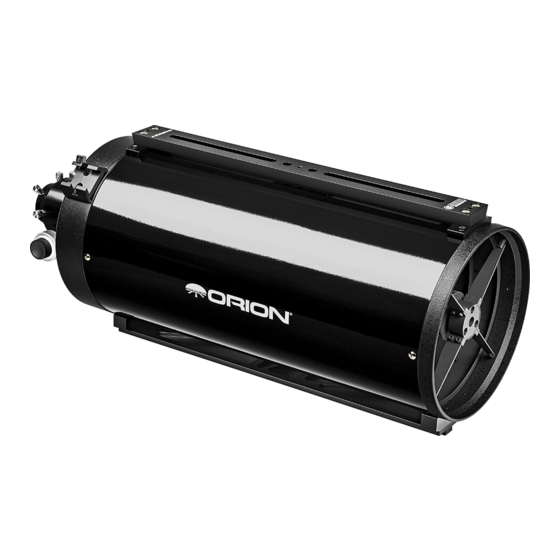
Table of Contents
Advertisement
Quick Links
Orion
Classical Cassegrain Telescopes
Providing Exceptional Consumer Optical Products Since 1975
All Rights Reserved. No part of this product instruction or any of its contents may be reproduced, copied, modified or adapted,
CC6 and CC8 f/12
®
#52138 CC6
#52139 CC8
#52138
#52139
Copyright © 2018 Orion Telescopes & Binoculars
without the prior written consent of Orion Telescopes & Binoculars.
Customer Support:
www.OrionTelescopes.com/contactus
Corporate Offices:
89 Hangar Way, Watsonville CA 95076 - USA
1
Advertisement
Table of Contents

Summary of Contents for ORION TELESCOPES & BINOCULARS CC6
- Page 1 Orion CC6 and CC8 f/12 ® Classical Cassegrain Telescopes #52138 CC6 #52139 CC8 #52138 #52139 Customer Support: www.OrionTelescopes.com/contactus Corporate Offices: Providing Exceptional Consumer Optical Products Since 1975 89 Hangar Way, Watsonville CA 95076 - USA Copyright © 2018 Orion Telescopes & Binoculars All Rights Reserved.
- Page 2 Particularly well suited for both visual observation and imaging of solar system subjects, but also of smaller deep-space objects, the CC6 and CC8 provide a welcome alternative to the myriad low-power, wide-field optical systems so common today. Enjoy your new telescope!
- Page 3 Grip-ring Dovetail finder scope bases Focuser attachment collar Coarse focus knob Fine focus knob Coarse focus knob Millimeter and inch scales Drawtube 2" accessary collar Thumbscrew locks 1.25" adapter Brass compression ring Drawtube tension Drawtube adjustment knob lock knob Figure 1 .
- Page 4 Focuser attachment collar 1.25" adapter Drawtube lock knob Thumbscrew locks Drawtube 1" extension ring 2" extension ring Attachment collar Linear bearing 2" accessary collar Drawtube tension Coarse focus knob Fine focus knob adjustment knob Figure 2. The linear bearing Crayford focuser on the 8” Classical Cassegrain provides extra drawtube rigidity to support heavier Figure 4.
- Page 5 And the bright circle to a compatible equatorial mount saddle plate. The CC6 has a is the reflective 45-degree surface of the Cheshire. The...
- Page 6 Secondary mirror holder Optical Reflective surface of axis collimating eyepiece Secondary mirror center ring Collimation eyepiece mark Spider vanes Figure 8. The view through a Cheshire collimating eyepiece (not to scale). A) The optics in perfect alignment. B) The secondary mirror slightly out of alignment.
- Page 7 one by one until the collimation eyepiece’s black dot is centered Choose a star close to the zenith (straight overhead) rather in the dark ring of the secondary mirror. The correct alignment than at the horizon to minimize atmospheric distortions. Using of the secondary mirror is critical in determining if the optical Polaris as your target star can be helpful as minimal drift adjust- axis requires alignment.
- Page 8 Specifications Optical configuration: Classical Cassegrain Classical Cassegrain Primary mirror figure: Paraboloid Paraboloid Secondary mirror figure: Hyperboloid Hyperboloid Mirror material: Quartz (SiO2) Quartz (SiO2) Mirror coating: Enhanced, 96% with SiO2 overcoat Enhanced, 96% with SiO2 overcoat Focuser: Dual-speed (10:1) Crayford, 2" (with 1.25" adapter) Dual-speed (10:1) Crayford, 2"(with 1.25"...















Need help?
Do you have a question about the CC6 and is the answer not in the manual?
Questions and answers